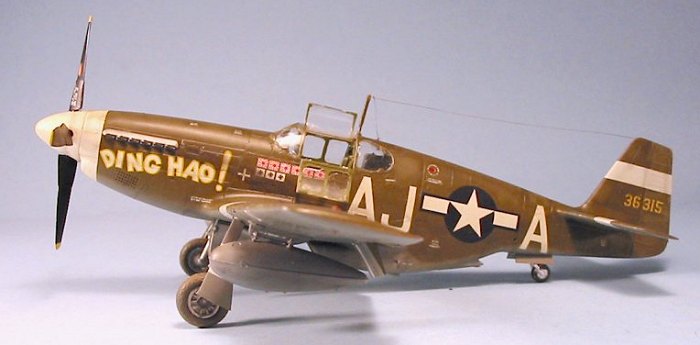
Tamiya 1/48 P-51B Mustang
|
KIT # |
61042 |
|
PRICE: |
$26.00 MSRP |
|
DECALS: |
Two options |
|
REVIEWER: |
Tom Cleaver |
|
NOTES: |

|
HISTORY |
James O. Howard and “Ding Hao!”:
Born in China, the son of Methodist missionaries, James O. Howard joined the U.S. Navy in 1938. After graduating from flight school at Pensacola, Ensign Howard was assigned to VF-6, flying the Grumman F3F-2 off the USS “Enterprise.” Those readers who have seen the Warner Brothers movie “Dive Bomber” have seen Howard: he’s flying 6-F-18 at the end of a long formation of F3F-2s in one of the air-to-air shots. In the Spring of 1941, tiring of the life of a junior officer in a prewar squadron and interested in what was happening in the country of his birth, Howard was one of 100 young American pilots from the USN, USMC and USAAC to resign his commission and join the American Volunteer Group, headed to war in China.
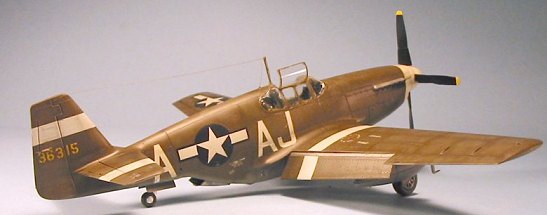 Howard was
assigned to the Second Squadron of the AVG, as the senior Flight Leader
under Squadron Leader Jack Newkirk, and first saw combat when the “Panda
Bears” of the 2nd Squadron relieved the “Hells Angels” in
Rangoon on December 30, 1941, following the week of battles with the JAAF
that began on December 23 and had seen the AVG christened “The Flying
Tigers” after the great air battle over Rangoon on Christmas Day. On
January 3, 1942, Jack Newkirk led Tex Hill and Howard on a dawn strafing
mission against the Japanese fighter base at Tak airdrome in Thailand.
The three P-40s arrived over the field just as the 77th Sentai
was preparing to take off for a mission to Rangoon. With 8-10 Ki.27s
already airborne, the strafing mission was even more dangerous than
expected. As Howard strafed a Nakajima preparing to take off, Tex Hill
shot another off his tail. Then Howard was hit by ground fire, and his
engine died. As Newkirk and Hill raced away, Howard set up for a crash
landing. At the last moment, the Allison came back to life, and Howard
was able to make his getaway.
Howard was
assigned to the Second Squadron of the AVG, as the senior Flight Leader
under Squadron Leader Jack Newkirk, and first saw combat when the “Panda
Bears” of the 2nd Squadron relieved the “Hells Angels” in
Rangoon on December 30, 1941, following the week of battles with the JAAF
that began on December 23 and had seen the AVG christened “The Flying
Tigers” after the great air battle over Rangoon on Christmas Day. On
January 3, 1942, Jack Newkirk led Tex Hill and Howard on a dawn strafing
mission against the Japanese fighter base at Tak airdrome in Thailand.
The three P-40s arrived over the field just as the 77th Sentai
was preparing to take off for a mission to Rangoon. With 8-10 Ki.27s
already airborne, the strafing mission was even more dangerous than
expected. As Howard strafed a Nakajima preparing to take off, Tex Hill
shot another off his tail. Then Howard was hit by ground fire, and his
engine died. As Newkirk and Hill raced away, Howard set up for a crash
landing. At the last moment, the Allison came back to life, and Howard
was able to make his getaway.
On January 4, Howard met the enemy in aerial combat when the JAAF attacked Mingaladon Airdrome, during which the Pandas shot down six fighters and eight bombers, of which Howard claimed one Ki.27 exploded. With two more fighters shot down the following day, and two Ki.21 bombers on January 6, Howard was an ace. On January 23, he scored his sixth and final AVG victory, another Ki.21 over Rangoon.
Following the
disbandment of the AVG on July 4, 1942, Howard returned to the United
States. That fall, he was inducted into the USAAF, promoted to Captain,
and sent to a P-38 group; at a height of 6' 2," he was considered too big
to fit in a P-39. Howard soon realized the P-38 was an airplane still
full of problems, and that it would be awhile before he would ever see
operations again. A friend had joined a new P-39 group and let him know
there was need of a senior squadron commander. He managed to convince
General William Kepner that
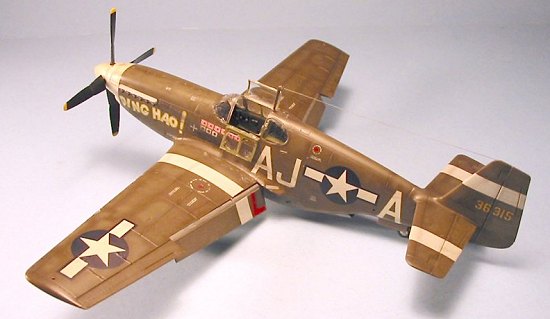 he could indeed fit inside a P-39, and was
thus assigned in the spring of 1943 to the 354th Fighter Group
as commander of the 356th Fighter Squadron, then training at
Hamilton Field north of San Francisco. Howard’s combat experience was
put to good use in training the younger pilots. That fall, the 354th
arrived in England as part of the tactical Ninth Air Force.
he could indeed fit inside a P-39, and was
thus assigned in the spring of 1943 to the 354th Fighter Group
as commander of the 356th Fighter Squadron, then training at
Hamilton Field north of San Francisco. Howard’s combat experience was
put to good use in training the younger pilots. That fall, the 354th
arrived in England as part of the tactical Ninth Air Force.
In September, 1943, the 354th was assigned to Boxted Airdrome, where they found themselves equipped with the brand-new North American P-51B Mustang. At the time, because the RAF had used the Allison-powered Mustang as a tactical fighter, the Merlin-powered P-51B was assigned to a similar role in the USAAF, since the P-47 had been chosen as the escort fighter for the 8th Air Force. Even without drop tanks, the Allison Mustang had been the first single-engine fighter capable of flying to targets in Germany from England. With two 75-gallon drop tanks, it was discovered the P-51B had the longest range of any USAAF fighter. As Howard later described the airplane, “it was a fighter pilot’s dream.”
On October 14, 1943, the Luftwaffe fought the 8th Air Force daylight bombing offensive to a halt over Schweinfurt. After losing 65 of 290 unescorted B-17s that day, with nearly all the survivors hit by enemy fire, the 8th Air Force didn’t have 100 bombers that could have flown a mission the next day. Fortunately, bad weather over the Continent for the next six weeks covered the failure of unescorted daylight bombing, during which time two P-38-equipped groups - the 20th and 55th Fighter Groups - went operational in the 8th. By the end of November, the 354th - which had taken the name “Pioneer Mustangs” - was ready for operations. Two 9th Air Force P-47 groups were already flying escort missions for the 8th Air Force while the organization built its strength, and the 354th was also given that assignment.
Lt. Col. Don Blakeslee, at the time Deputy Group Commander in the 4th Fighter Group, led the 354th on their first operational missions. The Mustang was the plane Blakeslee had been looking for: one with the performance of a Spitfire and the range to go anywhere in Europe. His reports finally got the attention of 8th Air Force HQ, and the 354th was temporarily assigned full-time to the 8th Air Force for escort missions, though the 9th Air Force would not give up complete control of the best fighter in their command.
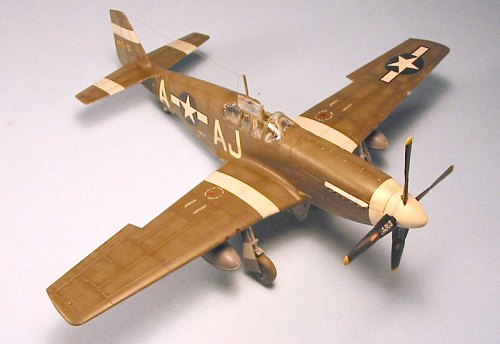 With their
first escort mission on December 13, 1943, the 354th proved
the worth of the Mustang, as they provided target support over Kiel - at
the time, this was the longest-range mission flown by the 8th,
well over 400 miles one way. In following missions during December,
Howard alternated leading the group with Group Commander Harold Martin,
with one flying wing on the other alternately, inasmuch as Howard had the
most combat experience of any man in the 354th. In January 1944, Howard
and Martin began alternating missions as group leader. During this time,
they were still working out the “bugs” in the P-51, with the result that
frequently over half the unit would have aborted for mechanical failures
by the time they reached the target. As the only fighter group in the
ETO capable of performing their mission, it was “do or die” regardless of
how many airplanes made it over the target. On January 1, the group
“came into its own” with a mission to Kiel that resulted in 15 pilots
claiming the destruction of 16 Bf-110s and Me-210s that attacked the
bombers.
With their
first escort mission on December 13, 1943, the 354th proved
the worth of the Mustang, as they provided target support over Kiel - at
the time, this was the longest-range mission flown by the 8th,
well over 400 miles one way. In following missions during December,
Howard alternated leading the group with Group Commander Harold Martin,
with one flying wing on the other alternately, inasmuch as Howard had the
most combat experience of any man in the 354th. In January 1944, Howard
and Martin began alternating missions as group leader. During this time,
they were still working out the “bugs” in the P-51, with the result that
frequently over half the unit would have aborted for mechanical failures
by the time they reached the target. As the only fighter group in the
ETO capable of performing their mission, it was “do or die” regardless of
how many airplanes made it over the target. On January 1, the group
“came into its own” with a mission to Kiel that resulted in 15 pilots
claiming the destruction of 16 Bf-110s and Me-210s that attacked the
bombers.
On January 11, 1944, Howard led the group on a target support escort mission to Oschersleben and Halberstadt, 60 miles southwest of Berlin in central Germany. By now, his Mustang carried the name “Ding Hao!” which was Chinese for “Very Good.” As the 354th reached the bomber stream, they saw the B-17s and B-24s were already under heavy attack from the Luftwaffe. Howard dispatched the 353rd “Fighting Cobras” to the far side of the stream, while directing the 355th “Pugnacious Pups” to cover the near side, while he took the 356th “Red Ass” squadron (so named in tribute to how a pilot felt after a 6-hour mission in a P-51) to the head of the stream. Fewer than 40 Mustangs had to provide cover for over 500 bombers.
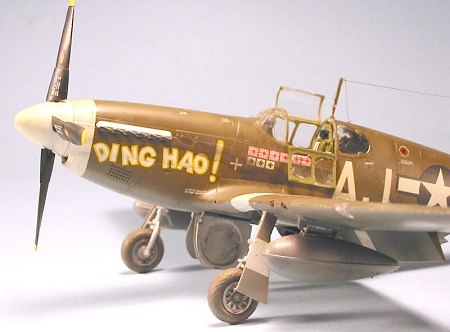 As the 356th
arrived in position, 36 Bf-109s, Bf-110s and Fw-190s dove through the
Mustangs as they headed toward the bombers. Howard latched onto a Bf-110
and exploded it. As he closed on a Fw-190, the pilot bailed out before
he could open fire. Howard became separated from the rest of the group,
and was now the sole defender of the bomber box, in lone battle against
more than 30 enemy fighters. Richard Turner described what happened next
in his memoir “Big Friend, Little Friend”:
As the 356th
arrived in position, 36 Bf-109s, Bf-110s and Fw-190s dove through the
Mustangs as they headed toward the bombers. Howard latched onto a Bf-110
and exploded it. As he closed on a Fw-190, the pilot bailed out before
he could open fire. Howard became separated from the rest of the group,
and was now the sole defender of the bomber box, in lone battle against
more than 30 enemy fighters. Richard Turner described what happened next
in his memoir “Big Friend, Little Friend”:
“Howard wasted no time in maneuvering, but lunged head-long with engine at full bore, challenging the whole stinking mess in a brazen direct frontal attack, a magnificent but futile and fatal sacrifice, seemingly, to the on-looking bomber crews who could see the astronomical odds. The entranced bomber crews watched in admiration and fascinated awe as the tiny Mustang hurtled into unrelenting interception of the massive German gaggle, but instinctively prepared for heavy attack following the expected sure destruction of their lone defender.” Howard’s account of the action states “I was so busy in my constant pursuit of the enemy fighters, I may not have seen the presence of other enemy aircraft that were out of my visual range.”
The P-51B at that time had a big problem in that the guns were installed at an angle in the thin wing, which meant the ammo belt feeds could become jammed under application of high-G maneuvers. On his first swing toward the Germans, Howard lost one gun. More German fighters made attacks on the bombers and he was soon down to one operating weapon, the outboard left machine gun; this threw off his aim, but he continued attacking the enemy, forcing the breakup of their formations and blunting their attacks on the bombers. By this point, his combat against the Germans had been going on for 30 minutes. Now low on ammunition, Howard made feint attacks, which still forced them to maneuver away, thus protecting the B-17s. A few moments later, as he chased off a persistent Ju-88, Howard was forced to break off combat to return to England. As Major Allison Brooks, leader of the bomb group that day later recalled, “For sheer determination and guts, it was the greatest exhibition I’ve ever seen. It was a case of one lone American against what seemed to be the entire Luftwaffe.”
 While the 354th
had its best day to date, with claims of 18 destroyed, 8 probables and 16
damaged - of which Howard claimed two destroyed, two probables, and two
damaged - the bombers had lost 55 aircraft to the Luftwaffe. One
group of Mustangs was not that big a change in fortune.
While the 354th
had its best day to date, with claims of 18 destroyed, 8 probables and 16
damaged - of which Howard claimed two destroyed, two probables, and two
damaged - the bombers had lost 55 aircraft to the Luftwaffe. One
group of Mustangs was not that big a change in fortune.
The next day, 8th Air Force commander Jimmy Doolittle asked 9th Air Force fighter commander Pete Quesada who the lone pilot who had taken on 30 enemy aircraft was, since the survivors of the 401st Bomb Group wanted to know who had saved them. Examination of Howard’s gun camera film, which saw him awarded four victories, revealed he was the pilot everyone was looking for. When the press - including Walter Cronkite, Marguerite Higgins and Andy Rooney - was brought in later that week to meet Howard, it was also the first public presentation of the P-51 Mustang in the ETO. “True” magazine published a painting of Howard with his airplane on their cover, with the title “One Man Air Force.”
In May, 1944, upon completion of his combat tour, Lt. Colonel James O. Howard became the only American fighter pilot in the ETO to be awarded the Medal of Honor.
The 354th became the highest-scoring Fighter Group in the ETO with 701 aerial victories; the 353rd Fighter Squadron was the top-scoring P-51 squadron of the war with 276.5 aerial victories. Their list of 41 aces created during 17 months of combat was higher than that achieved by any other Fighter Group in the 8th, 9th, or 15th Air Forces during the war.
|
THE KIT |
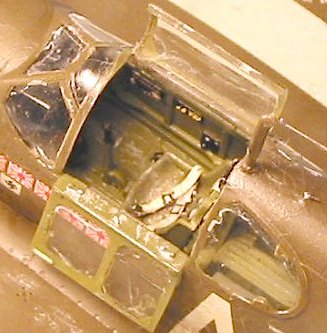 It’s hard to
believe that the Tamiya P-51B Mustang has now been on the market for nine
years, but it’s true. Following the introduction of the P-51D in the
fall of 1994, the P-51B gave Tamiya the title for “Best P-51 Kits.” In
my opinion, these two kits are - with the Tamiya P-47 Thunderbolts -
among the best plastic airplane kits available in 1/48 scale. The only
way a modeler can screw up the assembly of these Mustangs is to actively
work on making a mistake. They are so well-designed that I have never
used more than a bit of putty or Mr. Surfacer along the centerline under
the radiator intake on any of the many P-51Bs and P-51Ds I have made in
the past ten years from these kits. The only “mistake” in the P-51B kit
is that it has a cockpit floor atop the wing, like the preceding Allison
Mustangs; the Merlin Mustangs had a deeper cockpit with a flat floor.
However, once the kit is assembled, this is not that noticeable. While I
almost always use a True Details cockpit when making a Tamiya P-51D, I
have yet to use a resin cockpit for any of my P-51Bs.
It’s hard to
believe that the Tamiya P-51B Mustang has now been on the market for nine
years, but it’s true. Following the introduction of the P-51D in the
fall of 1994, the P-51B gave Tamiya the title for “Best P-51 Kits.” In
my opinion, these two kits are - with the Tamiya P-47 Thunderbolts -
among the best plastic airplane kits available in 1/48 scale. The only
way a modeler can screw up the assembly of these Mustangs is to actively
work on making a mistake. They are so well-designed that I have never
used more than a bit of putty or Mr. Surfacer along the centerline under
the radiator intake on any of the many P-51Bs and P-51Ds I have made in
the past ten years from these kits. The only “mistake” in the P-51B kit
is that it has a cockpit floor atop the wing, like the preceding Allison
Mustangs; the Merlin Mustangs had a deeper cockpit with a flat floor.
However, once the kit is assembled, this is not that noticeable. While I
almost always use a True Details cockpit when making a Tamiya P-51D, I
have yet to use a resin cockpit for any of my P-51Bs.
With an airplane as popular as the P-51 is, the aftermaket decal folks have brought out perhaps the greatest number of decal sheets dedicated to a single type other than the Bf-109 series, and continue to do so. If I was to limit myself to just building P-51s and using only the decal sheets I have on hand now with no new ones purchased, I suspect I could likely put in a good ten years of production, with each model in different markings.
I may build other models, but no matter how many times I tell myself “you’ve done enough P-51s, buddy,” I find at least once a year that I have returned to build another, generally followed by two or three more until my “fix” has been met.
|
CONSTRUCTION |
 There are
several construction articles for this kit available at this site. All I
can say is, follow the instructions, assemble it per the assembly order
shown there, and you will have an excellent model. In fact, any modeler
who - once they have painted the cockpit parts - cannot assemble one of
these kits in an evening should check in with a doctor to see what their
dexterity problem is, the kit is that well designed and that simple.
There are
several construction articles for this kit available at this site. All I
can say is, follow the instructions, assemble it per the assembly order
shown there, and you will have an excellent model. In fact, any modeler
who - once they have painted the cockpit parts - cannot assemble one of
these kits in an evening should check in with a doctor to see what their
dexterity problem is, the kit is that well designed and that simple.
There is one thing to bring up in the assembly of this kit, because it is the single most obvious mistake modelers make with P-51 models: Mustang landing gear legs ARE NOT installed vertical to the wing when seen in side profile!!! How modelers manage to screw this one up is beyond me, because if they merely follow the way the kit is designed and install the gear so it fits without hassle in the relevant holes, the gear will be at the proper raked-forward angle. So, don’t fight the kit on this: it knows more than you do.
|
COLORS AND MARKINGS |
Painting:
I used Gunze-Sangyo Olive Drab and Tamiya Neutral Grey for this model, with Tamiya Flat White for the ID markings.
After pre-shading the model, I painted the wheel wells with SNJ Aluminum. For those who keep asking and asking, here is the answer to the most frequently-asked Mustang modeling question:
Mustang wheel wells, gear door interiors, and landing gear were painted at the factory in Aluminum lacquer!!! That part of the main spar visible at the rear of the wheel bay is painted in Yellow Zinc Chromate. Mustang wheel wells are NOT painted Interior Green, Yellow Zinc Chromate, any other shade of Green, or Pink, Yellow or Purple! Got it???
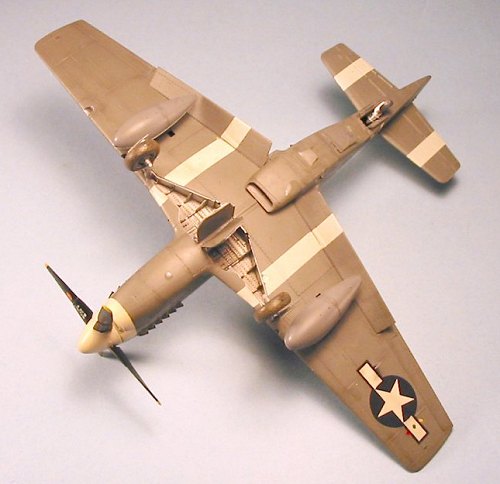 Because the
P-51 had a superficial resemblance to the Bf-109, the aircraft ended up
with the most extensive identification markings of any Allied fighter
flown in the ETO. The airplane was given 12 inch wide stripes around the
wing and horizontal stabilizer, with the inner edge of the wing stripe 18
inches from the wing-fuselage joint line and the stabilizer stripes in
line with the wing stripes, and an 8 inch wide rudder stripe that was
later overpainted when it was discovered that the visual effect of the
white stripe on an OD fin was to “shorten” the fin and make the
airplane even more “109-like” to the casual observer. In 1/48 scale, that
means the wing and stabilizer stripes are 1/4 inch wide, while the
vertical fin stripe is about 3/16 inch wide. The 354th had
only applied all these markings in late December/early January, so I
applied the rudder stripe to this model. The spinner was painted white,
as well as the forward 8 inches of the fuselage (basically back to the
exhaust covers).
Because the
P-51 had a superficial resemblance to the Bf-109, the aircraft ended up
with the most extensive identification markings of any Allied fighter
flown in the ETO. The airplane was given 12 inch wide stripes around the
wing and horizontal stabilizer, with the inner edge of the wing stripe 18
inches from the wing-fuselage joint line and the stabilizer stripes in
line with the wing stripes, and an 8 inch wide rudder stripe that was
later overpainted when it was discovered that the visual effect of the
white stripe on an OD fin was to “shorten” the fin and make the
airplane even more “109-like” to the casual observer. In 1/48 scale, that
means the wing and stabilizer stripes are 1/4 inch wide, while the
vertical fin stripe is about 3/16 inch wide. The 354th had
only applied all these markings in late December/early January, so I
applied the rudder stripe to this model. The spinner was painted white,
as well as the forward 8 inches of the fuselage (basically back to the
exhaust covers).
For variation in the paint scheme, I did some post-shading of the upper surface Olive Drab to give an impression of ultraviolet sun fading. Aircraft in the ETO - where it was cloudy most of the time - did not get much opportunity for sun-fading as they sat on their airfields; the sun-fading occurred at high altitude, from ultraviolet light. The result is that the paint tended to fade in such a way as to tend toward a purplish color. What I do is add it a bit of Gunze-Sangyo Violet to the Olive Drab, and go back over the upper surfaces. I add in a bit of yellow for fading the fabric surfaces, and do the fading more on upper-facing surfaces than side-facing surfaces. This should all be very subtle, since this particular airplane was still basically new. When all was finished I gave the model a coat of Future.
Decals:
SuperScale has
made a sheet several years ago that has “Ding Hao!” on it, which may be
found though it is currently out of production. I used the sheet
from “Aeromaster” I bought several years ago. These provide the
markings for Howard’s original airplane as it was after the January 11,
1944 m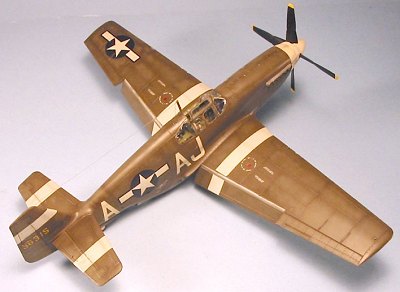 ission.
The airplane later received a Malcolm hood, and he also had a second P-51
with a Malcolm hood in the same markings. Be sure to check the
serial number as to which one you are building. I used the kit decals for
the servicing stencils. Once the decals were set, I washed off the
dried-on decal solvent and gave the model another coat of Future.
ission.
The airplane later received a Malcolm hood, and he also had a second P-51
with a Malcolm hood in the same markings. Be sure to check the
serial number as to which one you are building. I used the kit decals for
the servicing stencils. Once the decals were set, I washed off the
dried-on decal solvent and gave the model another coat of Future.
Final Finish:
At this point in its career, “Ding Hao!” was a relatively new airplane; additionally, in the ETO the mission load was low enough due to winter weather that the ground crews had time for maintenance. Thus, the model is relatively clean as regards “dings.” I gave it two coats of thinned Dullcote to result in a “flattened-satin finish” that would approximate what it looked like after being given a coat of auto polish by the ground crew. I gave a light bit of exhaust stains with Tamiya “Smoke.”
|
CONCLUSIONS |
So, bunky, you find yourself stressed out with all that AMS crud, trying to create next year’s Nats winner, to the point modeling’s starting to feel like day labor work?? Follow the doctor’s guaranteed cure for AMS: go buy a Tamiya P-51B and a set of decals you like, and build the kit out of the box. It’s a nice weekend project, the result will always look outstanding, and you’ll have another example of World War II’s best fighter in your collection. They’re like what Hemingway said about cats: “having one leads to another.” Enjoy!!
|
REFERENCES |
Howard, James O. “Roar of the Tiger: From Flying Tigers to Mustangs -a Fighter Pilot’s Memoir;” New York: Orion Books; 1991.
February 2004
Copyright ModelingMadness.com
Kit courtesy of my wallet.
If you would like your product reviewed fairly and fairly quickly, please contact the editor or see other details in the Note to Contributors.